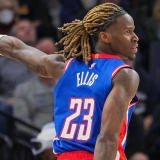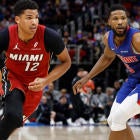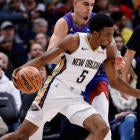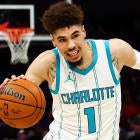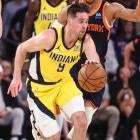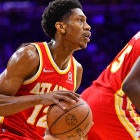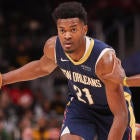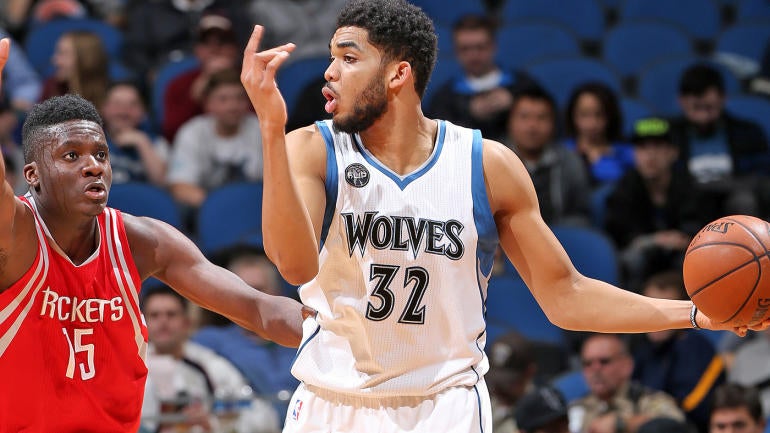
The faces of the center position have changed dramatically over the past few seasons. Only one of the five players pegged as an "elite" Fantasy talent appeared on an All-NBA or All-Star team two seasons ago (DeMarcus Cousins). The rest are relative newcomers.
Karl-Anthony Towns and Nikola Jokic were both second-year players last season. Rudy Gobert just completed his fourth season, but only became a full-time starter in 2015-16. Hassan Whiteside was drafted back in 2010 but didn't truly come into his own until recently.
With the landscape of the position changing so quickly and dramatically, casual Fantasy Basketball players might gloss over some of the most important names out there. If you fall into that category, these tiers should help clear things up.
Tier I: The Elite
Karl-Anthony Towns, Nikola Jokic, DeMarcus Cousins, Rudy Gobert, Hassan Whiteside
The 2015-16 Rookie of the Year burst onto the scene as a truly elite talent last season. Towns is a potentially transcendent player at the position and is essentially the archetype for the modern NBA center. While questions remain about his defensive ability, he still managed to average a combined 2.0 blocks and steals last season at age 21.
From Jan. 1 through the end of the season, Jokic averaged 19.7 points, 11.4 rebounds, 5.8 assists and a combined 1.8 steals and blocks. He also shot 57.5 percent from the field and 32.7 percent from deep on 2.4 attempts per game. Jokic is one of the most unique centers in the NBA, equally comfortable scoring as he is firing dimes from anywhere on the floor. Given his passing ability from the center slot, drafting him early means there's less pressure to pick up an elite-passing point guard, while others in your league scramble to do so.
After coming over from Sacramento, Cousins averaged 24.4 points, 12.4 rebounds, 3.9 assists, 1.5 steals and 1.1 blocks in 33.8 minutes per game playing alongside Anthony Davis. While it's possible his assists take a slight dip due to the addition of Rajon Rondo alongside Jrue Holiday, it's difficult to imagine a scenario in which Cousins' Fantasy value dips significantly.
Tier II: The High-Impact
DeAndre Jordan, Andre Drummond, Joel Embiid, Myles Turner, Marc Gasol, Brook Lopez, Jusuf Nurkic
The only reason Embiid doesn't fall within Tier I is his injury history. Embiid put together an impressive rookie campaign, averaging 20.2 points, 7.8 rebounds, 2.5 blocks and 2.1 assists across just 25.4 minutes per game. He also shot 46.6 percent from the field and made 1.2 threes per game at a 36.7 percent clip. The catch? He only played in 33 games, with a knee injury ending his season shortly after the All-Star break. Drafting Embiid entails massive risk, to be sure. But the possible rewards are too great to pass up should he slide further than this tier on the draft board.
Turner fits the mold of the prototypical modern center – he's athletic, he blocks shots and he can stretch the floor. The 2017-18 season looks like it could have the makings of a breakout campaign for Turner, as the Pacers' top two scorers from last season -- Paul George and Jeff Teague -- are no longer with the team. The Pacers didn't replace the pair with high-caliber offensive talent, either.
While he was, and will continue to be, the third offensive option behind Damian Lillard and C.J. McCollum, Nurkic is nonetheless an impact offensive player. His free throw shooting may be an issue, as he shot just 66.0 percent after the trade. That said, considering everything else he does on the floor, problems at the charity stripe shouldn't prevent Nurkic from having top-10 center potential.
Tier III: The Upper-Mid-Tier
Al Horford, Nikola Vucevic, Dwight Howard, Marcin Gortat, Jonas Valanciunas, Clint Capela
Horford had a productive yet rather unusual 2016-17 campaign. He averaged a career-low 6.8 boards, but also a career-high 5.0 assists per game. His scoring also took a slight dip from 15.2 to 14.0 points per game. With the addition of Gordon Hayward, who excels with the ball in his hands, Horford's role is somewhat up in the air heading into the season. It's unclear whether he'll still be tasked with significant distribution duties.
While Howard's scoring has dropped each year since 2013-14, his field-goal percentage has steadily risen, and he capped last season shooting better than 63 percent. However, he's not the shot blocker he was, averaging a career-low 1.2 rejections per game last season. Chemistry issues and some declining numbers aside, Howard is still an imposing physical presence and is essentially a lock to play close to 30 minutes a night. He's nowhere near the force he once was, but he still posted a double-double in 53 of 74 games last season.
Capela has steadily improved since making his debut back in 2014-15. His production topped off last season at 12.6 points, 8.1 rebounds, 1.2 blocks and 1.0 assist in only 23.9 minutes per game. While he played just 65 games last season while recovering from a fractured fibula, he more than demonstrated his potential as the perfect rim-running, rebounding center for the Rockets' fast-paced offense.
Tier IV: The Strong Role Players
Steven Adams, Enes Kanter, Tristan Thompson, Tyson Chandler, Nerlens Noel, Greg Monroe, Willie Cauley-Stein, Pau Gasol, Wily Hernangomez
Monroe accepted a bench role last season, but produced well in limited action. In his 22.5 minutes per game, Monroe managed averages of 11.7 points, 6.6 boards, 2.3 assists and 1.1 steals. Monroe didn't play big minutes often, but excelled when he did, posting 17.7 points, 9.6 rebounds and 2.8 assists while shooting 57.6 percent from the field in games when he saw at least 30 minutes.
Cauley-Stein emerged after the DeMarcus Cousins trade created a vacuum at the center slot. After the All-Star break, Cauley-Stein garnered 30.9 minutes, which he translated to 12.9 points, 8.2 rebounds, 2.2 assists and 1.1 steals per game. While he isn't a great scorer, the 24-year-old has demonstrated upside as a rebounder and defender. He's also a willing passer, registering five games last season with at least five assists, all of which occurred after the Cousins trade.
Hernangomez was the primary, and perhaps the only, beneficiary of Joakim Noah's disastrous and injury-plagued 2016-17 campaign. After Feb. 27, Hernangomez averaged 11.6 points, 9.1 rebounds, 2.0 assists and a combined 1.2 steals and blocks per game, providing a few bright spots in an otherwise gloomy Knicks season.
Tier V: The Rest
Frank Kaminsky, Alan Williams, Alex Len, Dewayne Dedmon, Timofey Mozgov, Robin Lopez, Bismack Biyombo, Jahlil Okafor
Kaminsky will battle for minutes off the bench, and it's unclear at this point how the addition of Howard will shape the Hornets' rotations. The potential for three-point production (1.5 made threes per game last season) along with a couple of assists (2.2 per game) is intriguing, but Kaminsky is an inefficient scorer and underwhelming on the defensive end.
Both Dedmon and Mozgov find themselves in better situations this season. The Hawks and Nets will be among the worst teams in the league, but both players -- Mozgov, in particular -- will have great chances to start and play heavy minutes.
Lopez is likely the safest of the bunch, virtually locked into a starter role for the rebuilding Bulls. While he's only a marginal offensive player, the 29-year-old has averaged at least 6.4 rebounds and 1.4 blocks per game in each of the last four seasons.



